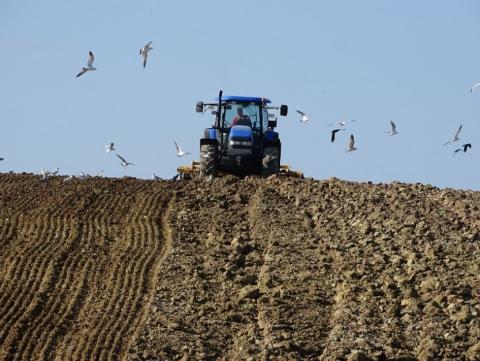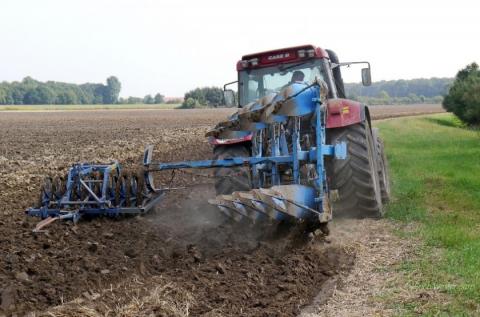Dr William Stiles: IBERS, Aberystwyth University.
Take home messages:
- Tillage creates significant disturbance to soil, which can have a negative influence on soil biology and soil organic matter levels.
- This can adversely affect soil health and function.
- Adopting no-till systems can increase soil health and function.
Soil tillage is the practice of mechanically disturbing soil in preparation for the growing of crops. This practice is typically employed to break up soil and to remove or destroy weed species, which may have become established. However, this disturbance can have negative consequences on soil ecosystem health and function.
Alternative methods for soil preparation include no tillage (no-till) and minimum tillage (min-till). No-till refers to a system where seeds are sown directly into un-cultivated soil, eliminating the need for ploughing. Min-till approaches offer an intermediate degree of disturbance, where only a proportion of the field is ploughed (strip tillage), or where only the near surface of the soil is disturbed, such as with disc or tine cultivators.
By avoiding disturbance and planting directly into the previous crop’s residues, soils are better protected
from extremes of climate, reducing the effects of nutrient leaching, soil erosion and runoff. It can also improve soil organic matter (SOM) levels in some instances and reduce the costs of production, by saving on labour and machinery inputs.
There is much evidence that limiting or stopping tillage is beneficial for soil health and function, but this does not necessarily translate into gains in crop yield. Nevertheless, tillage can have profound effects on soil biota and soil physical and chemical characteristics, and may increase the potential for physical degradation, such as erosion. Thus, reducing this activity will enhance the potential for soil resilience to future environmental change.
Effects on soil
Tillage can influence numerous physical characteristics in soil including water content, temperature, aeration, and the interaction between organic material and mineral particles. The degree of influence will be variable depending on soil type and composition.
The act of tillage requires significant mechanical action. This can increase the potential for soil compaction, particularly when undertaken in wet conditions, by increasing the need for heavy machinery usage. Reducing tillage does not necessarily solve the problem of compaction in agricultural soil, as heavy machinery will still be needed for other cultivation activities, but any reduction in required usage of heavy machinery could be considered beneficial.
The evidence for tillage effects on soil organic matter (SOM) and soil carbon (C) are varied, with studies reporting differing effects of no-till systems, ranging from beneficial to no effect. Tillage may affect SOM through reductions in arbuscular mycorrhizal fungi (AMF) hyphae length, which have been observed to be longer under no-till systems, and overall microbial biomass, which is typically smaller under conventional tillage systems. SOM is extremely important in terms of soil health (see box 1), but due to the variability in SOM levels observed as a result of tillage, the enhancement of SOM levels should not be the principal reason for adopting a no-till system. Furthermore, whilst there is potentially some benefit to SOM levels from reducing tillage, this should be treated cautiously and should not be translated into a suggestion of increased carbon sequestration potential via this approach, as this is unlikely to be an effective strategy.
Effects on soil biology
Soil fauna play a major role in soil-based processes and can influence soil physical and chemical characteristics. Alterations to the chemical and physical nature of a soil, as a result of tillage, can have sizeable effects on soil ecology. Soil organisms, from microorganisms such as bacteria, to larger organisms such as earthworms, play an essential part in organic matter breakdown and nutrient cycling. Larger organisms also alter soil structures by burrowing and creating channels along which air and water can be transported.
What is soil organic matter and why is it important?
Soil organic matter is a key component of soil health and can influence fertility levels, porosity, and infiltration rate. It is comprised of an active organic fraction, which includes soil-based microorganisms, and the remains of formerly living organisms, such as plants or animals, found in soil in a state of decomposition. The majority of this material originates from plant tissue and contains beneficial nutrients including carbon (C), sulphur (S), nitrogen (N), phosphorus (P), potassium (K), calcium (Ca) and magnesium (Mg). These will be available for uptake by other organisms in varying degrees, subject to the state of degradation.
Levels of SOM in soil are governed by a balance of inputs (from sources including crop residues, manure and others) versus outputs (from losses as a result of gradual decomposition). Thus, SOM levels will begin to decline where the rate of input to soil is less than the amount being lost.
This material plays a key role in many soil-based processes. From an agricultural perspective, SOM is important as it can positively influence both soil fertility and soil structure. Soil fertility is influenced by SOM both directly, through the release of nutrients during mineralisation of organic matter, and indirectly, as the material itself can absorb and hold nutrients which helps to avoid losses through leaching. Soil structure is improved by SOM through the process of aggregation, where soil particles are bound together into larger aggregates by various organic components, including microorganisms. SOM can also absorb and hold rainwater, improving its later availability for crop use.
The effects of tillage on soil organisms can be diverse. Soil arthropods (such as springtails and mites) are, in general, adversely affected. This happens directly through abrasion during tillage, or by being trapped in soil clods after inversion. It also happens indirectly through changes to soil moisture, pore continuity, litter accumulation and food availability where species in lower trophic levels are also affected. These organisms are numerous in the soil profile, constituting a major proportion of soil invertebrate biomass, and play a key role in numerous soil-based processes, including litter breakdown and nutrient cycling. The effects are similar for larger organisms such as earthworms. Earthworm populations are typically higher under no-till than conventional tillage. This is often the result of increased food availability from crop residues that are left in-situ on the soil surface. These residues can also moderate the influence of drying or freezing on the soil, which can increase earthworm activity periods.
Near-surface dwelling organisms, including beetles and spiders, are also adversely affected, both from
reduced food availability, as the food chain is affected or litter resources impacted, and from the loss of habitat in the form of cover offered by the near-surface litter layers. These species may seem less important in terms of soil processes; however, the relationships between larger predatory species and detrital food webs are complex and these organisms may well play an important role in pest control.
Summary
Tillage affects the function of soil through numerous pathways. The act of tillage is typically considered damaging to SOM and soil C levels, however this is likely to be variable depending on other factors, such as climate. Nevertheless, the negative influence on tillage on other factors, including soil biology, will have negative influences on soil-based processes, which in turn relate directly to soil health and function. It is well established that soil biology and soil health are related. Reducing practices such as tillage, which are harmful to these organisms will therefore have beneficial effects on the health and function of this system.
Reducing tillage, or adopting a no-till system, has been shown to benefit crop production through improvements to the quality of soil. Therefore, alternative approaches such as direct drilling offer greater potential in terms of production and present an opportunity to increase soil ecosystem function and, potentially, the sustainability of agricultural production.


